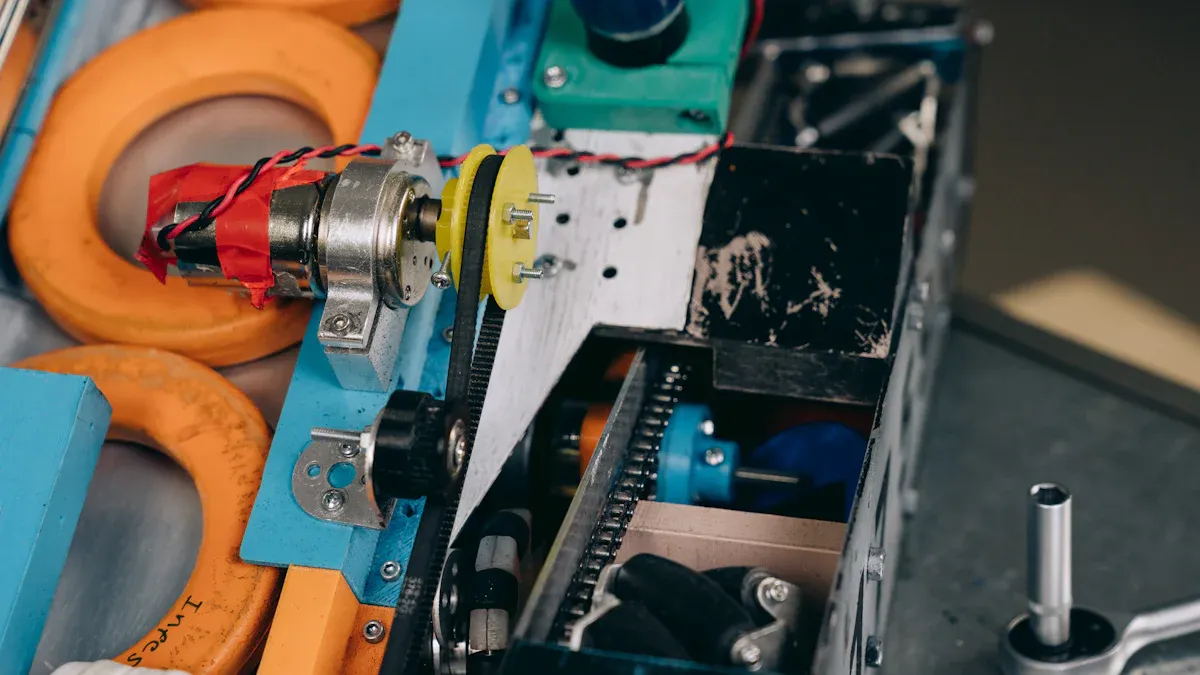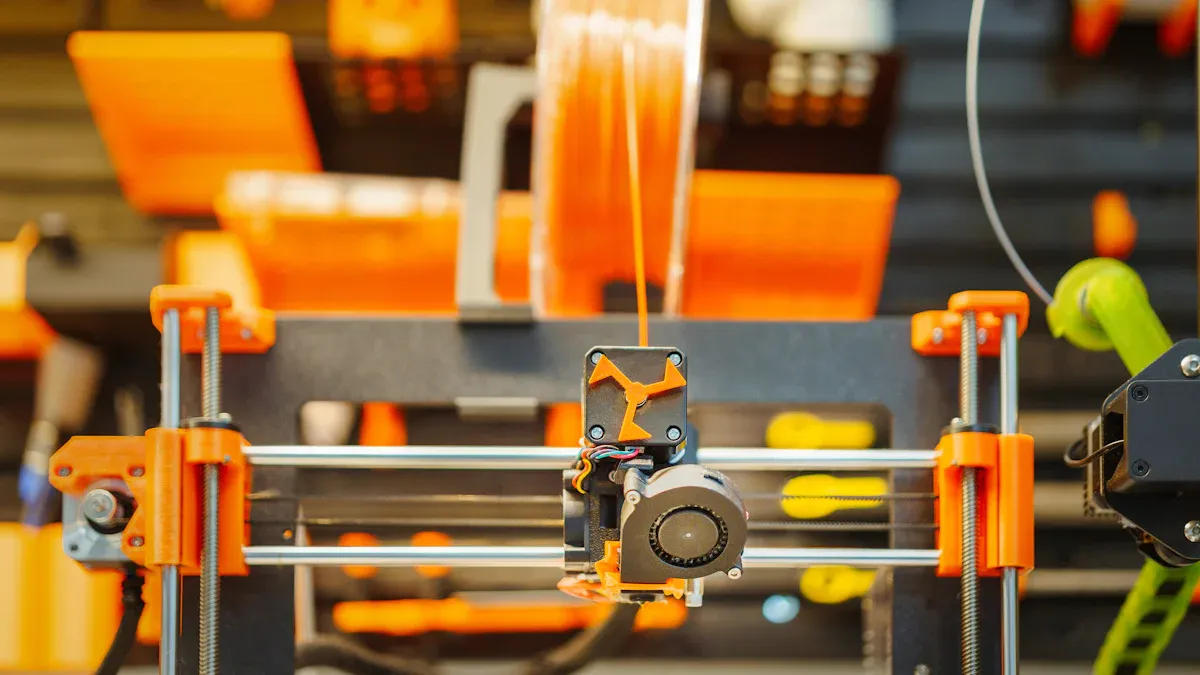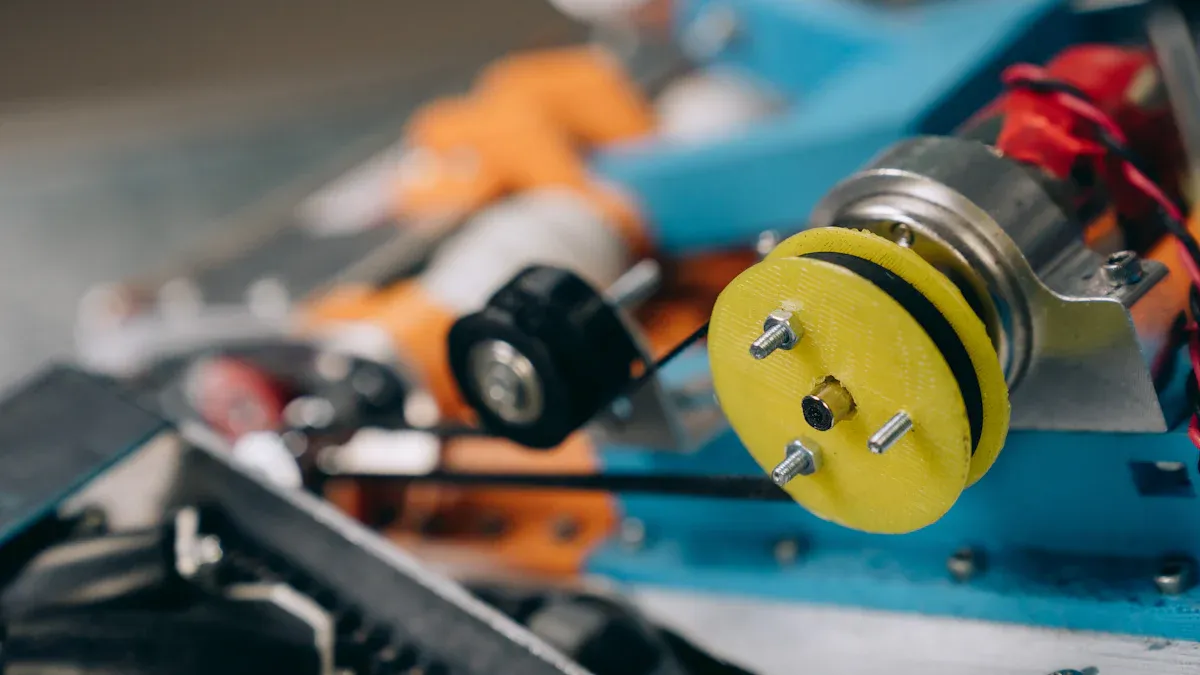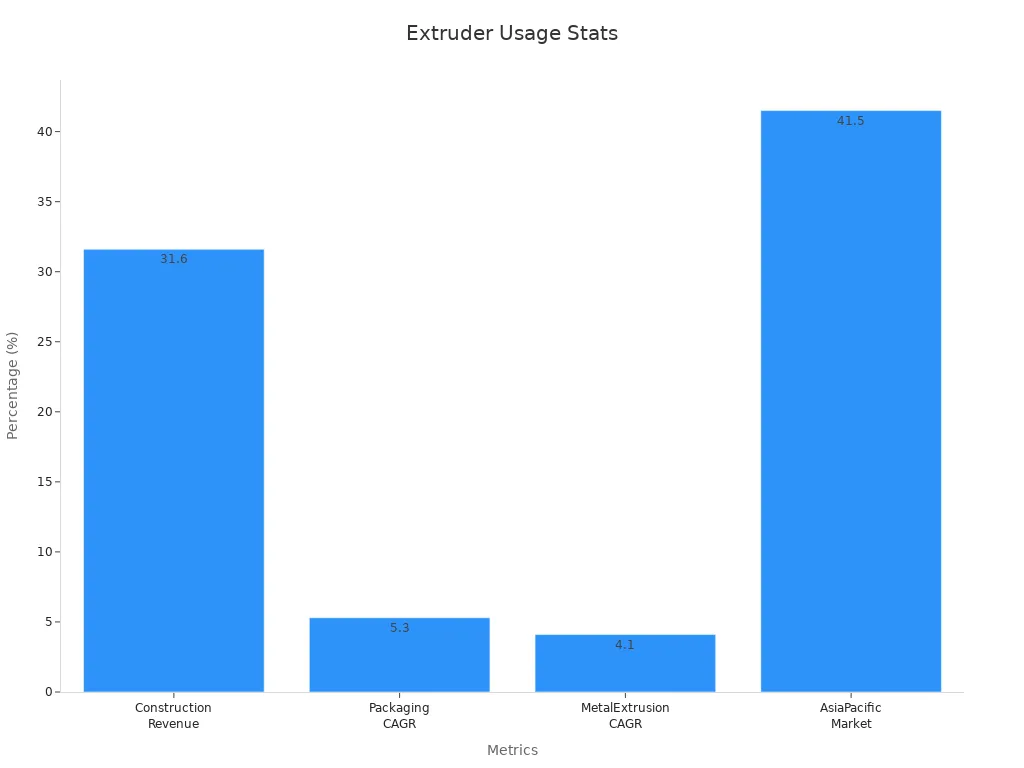
Twin screw extruder technology offers advanced mixing and high throughput, making it ideal for demanding plastic processing tasks. Single screw extruders remain popular for their cost-effectiveness and efficiency. Market growth reflects strong demand, with industries such as packaging and automotive relying on these machines for large-scale production. Twin Parallel Screw Barrel Supplier and Twin Screws For Plastic Extruders ensure consistent results, while Conical Twin Screw Twin Screw designs enhance flexibility.
Working Principles and Design Differences

Twin Screw Extruder Configuration
Twin screw extruders use two intermeshing screws that rotate together inside a barrel. These screws can be co-rotating or counter-rotating, depending on the application. The design allows for advanced mixing and compounding, making it possible to process a wide range of materials. Engineers can adjust screw diameter, profile, and barrel geometry to optimize output rate and product quality. Modular barrel construction and advanced control systems help maintain precise temperature and pressure. These features improve product uniformity and mechanical properties, especially in demanding applications like PVC pipe production.
Note: The intermeshing design maximizes mixing efficiency and supports self-cleaning, which reduces downtime.
Single Screw Extruder Design
Single screw extruders have a simpler design with one helical screw inside the barrel. This design uses fewer moving parts, making it easier to operate and maintain. The screw pushes material forward mainly through drag flow, which works well for steady flow materials. Internal screw cooling and a rectangular thread shape help manage temperature and ensure stable processing. The compact size and straightforward construction make single screw extruders cost-effective and suitable for large-scale production.
| Design Specification / Cost Factor | Single Screw Extruder Characteristics |
|---|---|
| Simplicity in Design | Fewer moving parts, easy to operate and maintain |
| Capital and Operating Costs | Lower investment and maintenance costs |
| Energy Efficiency | Consumes less power for simple tasks |
| Maintenance | Quick disassembly and cleaning |
| Throughput | High for simple materials |
Material Flow and Mixing Mechanism
Material flow in a twin screw extruder involves drag flow, pressure flow, and leakage flow. The intermeshing screws create shear and kneading effects, which improve mixing and additive dispersion. Co-rotating screws enhance mixing efficiency and help manage heat, reducing the risk of material degradation. In contrast, single screw extruders rely mostly on drag flow, which limits mixing capability but ensures steady output for simple materials. Screw geometry, speed, and material viscosity all influence flow and mixing performance.
Degassing and Self-Cleaning Features
Twin screw extruders excel at degassing because the intermeshing screws increase the surface area for gas release. Some systems boost degassing performance by up to 500% compared to single screw designs. Self-cleaning features, such as self-wiping screw action, help maintain process consistency and reduce downtime. Advanced filtration systems and precise control of extrusion parameters further support these benefits. Single screw extruders offer straightforward cleaning due to their simple construction, but they do not match the degassing efficiency of twin screw systems.
Performance Comparison

Mixing Capability and Homogeneity
Mixing quality stands as a defining factor in extrusion performance. Twin screw extruders deliver superior mixing due to their two intermeshing screws. These screws disperse and distribute additives efficiently, producing a more homogeneous melt. The self-wiping mechanism between the screws prevents material build-up and ensures thorough mixing. In controlled studies, twin screw extruders produced dry powder inhalation mixtures with blend uniformity and aerosol performance equal to or better than high-shear batch mixing. Researchers found that process parameters such as screw speed and feed rate did not significantly affect the consistency of the final product. This robustness allows manufacturers to achieve uniform mixtures and consistent product quality, even with complex formulations.
Twin screw extruders allow customization of mixing forces by adjusting screw profiles and elements. This flexibility enables optimization for specific materials and applications, resulting in enhanced dispersion and blend uniformity.
Throughput and Output Consistency
Throughput and output consistency are critical for industrial production. Twin screw extruders achieve higher throughput rates and process materials more efficiently than single screw models. They maintain precise process control, which leads to consistent product quality and fewer defects. The table below summarizes key differences:
| Extruder Type | Throughput Characteristics | Output Consistency Characteristics |
|---|---|---|
| Twin screw extruder | Higher throughput; efficient processing; energy efficient | Precise process control; superior mixing; consistent product quality; fewer defects and less waste |
| Single screw extruder | Moderate throughput; simpler and cost-effective | Challenges with pressure consistency; limited mixing capability; potential for uneven material distribution and product defects |
Single screw extruders may experience pressure fluctuations and material flow constraints, which can impact output uniformity. Twin screw extruders, on the other hand, provide stable operation and reliable results, making them ideal for large-scale production.
Material Handling and Flexibility
Material handling and flexibility determine how well an extruder adapts to different raw materials and formulations. Twin screw extruders excel in processing powders, difficult-to-feed materials, and complex blends. They offer superior dispersive and distributive mixing, handle a wide viscosity range, and incorporate multiple additives with ease. The table below highlights these distinctions:
| Feature | Single Screw Extruder | Twin Screw Extruder |
|---|---|---|
| Material Form | Best for pellets and granules | Better for powders and difficult-to-feed materials |
| Mixing Ability | Limited to distributive mixing | Superior dispersive and distributive mixing |
| Heat Sensitivity | Longer residence time | Shorter, more controlled residence time |
| Additive Incorporation | Basic additive incorporation | Handles complex formulations with multiple additives |
| Viscosity Range | Limited range | Wide viscosity range capability |
Twin screw extruders also provide enhanced process control, including precise temperature regulation and shorter residence times. These features benefit heat-sensitive materials and complex recipes. Single screw extruders remain cost-effective and reliable for uniform pellets but lack the flexibility and advanced mixing capabilities of twin screw systems.
Degassing Efficiency
Degassing removes trapped gases and moisture from the material during extrusion. Twin screw extruders offer excellent degassing efficiency due to their intermeshing screw design, which increases the surface area for gas release. This feature proves especially valuable in applications requiring high product purity or when processing materials prone to gas formation. Enhanced degassing leads to fewer defects and improved product quality. Single screw extruders provide basic degassing but cannot match the efficiency of twin screw extruders in demanding applications.
Self-Cleaning and Maintenance
Self-cleaning features reduce downtime and simplify maintenance. Twin screw extruders use self-wiping screw action to prevent material build-up and support continuous operation. Experimental data shows that adjusting extruder parameters such as width and layer height can improve surface roughness and wettability, enhancing self-cleaning performance. Materials like thermoplastic elastomers demonstrate high self-cleaning numbers, which translates to less manual cleaning and lower maintenance costs. Single screw extruders are easy to disassemble and clean due to their simple design, but they do not offer the same level of automated self-cleaning as twin screw systems.
Regular maintenance and optimized extruder settings help maintain high performance and extend equipment lifespan.
Application Suitability
Plastic Twin Screw Extruder Applications
A plastic twin screw extruder serves a wide range of industries that require advanced mixing, precise control, and flexibility. Manufacturers use these machines for compounding, masterbatch production, polymer blending, and processing recycled plastics. The modular design allows engineers to adjust screw profiles for specific materials, improving efficiency and product quality. Companies in the automotive and construction sectors rely on twin screw extruders for high-performance components. Technical reports highlight improvements in production efficiency and formula quality, especially in applications like engineering plastic modification and recycled material processing. The extruder barrel market continues to evolve, with increased adoption of twin and multi-screw extruders in high-volume and precision-demanding sectors such as pharmaceuticals and food processing.
Best Uses for Single Screw Extruders
Single screw extruders remain the preferred choice for simple, high-volume manufacturing tasks. These machines excel at producing products with consistent, dry formulations, such as pasta, basic pet food, and rice-based snacks. Their straightforward design ensures low maintenance and operational costs. The table below summarizes the best use cases:
| Product Type | Preferred Extrusion Type | Reasoning |
|---|---|---|
| Pasta | Single Screw | Simple dry formulation, minimal mixing |
| Basic Pet Food | Single or Twin Screw | Both work, single screw is cost-effective |
| Puffed Rice Snacks | Single Screw | Consistent dry input, high throughput |
A snack manufacturer producing puffed rice balls found single screw extruders ideal for simple recipes. However, when switching to multigrain products, they needed a twin screw extruder for better mixing and reduced waste.
Industry Examples
- Food companies like Nestlé and Kellogg’s invest in extrusion machinery to meet growing demand for processed foods.
- Construction and automotive sectors depend on extruded components, with firms such as Bausano and KraussMaffei providing tailored solutions.
- Additive manufacturing integrates with extrusion for customized production, as seen with CEAD and Arburg.
- Regulatory and environmental trends drive adoption of energy-efficient, biodegradable-compatible extrusion equipment.

Technological innovations, including automation and IoT connectivity, continue to improve production efficiency and product quality across industries.
Operational Considerations
Ease of Use and Training
Operators find modern extruder systems user-friendly due to advanced control interfaces. These systems display real-time data, alarms, and graphical overviews, which help operators monitor and adjust the process quickly. Training requirements depend on the extruder type. Single screw extruders have a straightforward design, so new operators can learn basic operation and troubleshooting in a short time. Twin screw extruders offer more features, such as recipe management and remote troubleshooting, which require additional training. Control systems with event logs and data collection help operators respond to process changes and maintain product quality.
Tip: Investing in operator training improves process stability and reduces the risk of errors.
Maintenance and Downtime
Regular maintenance keeps extruders running efficiently and extends their lifespan. Maintenance schedules differ between single screw and twin screw extruders. The table below highlights key focus areas:
| Extruder Type | Maintenance Focus Areas | Schedule Highlights |
|---|---|---|
| Single Screw | Feed throat cooling, screw/barrel wear, thrust bearing check | Oil change every 4,000-5,000 hours |
| Twin Screw | Screw alignment, torque distribution, barrel segment checks | Cooling system cleaned every six months |
Maintenance records track inspections, repairs, and part replacements. These records help teams spot recurring issues and plan preventive maintenance. Preventive maintenance can reduce downtime by up to 45% and add years to equipment life.
- Maintenance logs support troubleshooting and efficient scheduling.
- Neglecting records leads to longer downtimes and repeated repairs.
Cost and Return on Investment
Cost and return on investment (ROI) play a major role in extruder selection. Extrusion molding usually requires a lower initial investment than other methods, such as injection molding. Automated systems reduce labor costs and material waste, improving production efficiency. Continuous operation also lowers downtime, which boosts ROI for high-volume projects. Companies often choose extrusion for simple parts to maximize cost savings, while complex, high-precision parts may justify higher upfront costs in other processes. Careful evaluation of equipment costs, material use, and labor needs ensures the best long-term value.
Decision Guide
Choosing Based on Performance Needs
Selecting the right extruder system depends on a careful review of performance requirements. Many manufacturers use decision-making frameworks that combine techno-economic analysis, cost estimation models, and AI-assisted tools. These frameworks help users compare options based on cost, build time, material properties, and industry-specific needs. Multi-criteria decision-making methods, such as AHP, TOPSIS, and VIKOR, allow teams to evaluate both quantitative and qualitative factors. Interactive AI chatbots now provide tailored information, drawing from large research databases to support informed choices. Case studies show that this approach improves decision accuracy, with cost estimates closely matching real-world quotations for various components. The process empowers users to make independent decisions by presenting comprehensive data, rather than enforcing a single solution.
Tip: Use interactive tools and case studies to compare performance, cost, and material compatibility before making a final selection.
Key Questions to Consider
When choosing between a single screw or twin screw extruder, teams should review several mechanical and operational factors:
- What are the drive and resistive forces involved in the extrusion process?
- Which extrusion mechanism best fits the application?
- How does chamber design affect extrusion pressure and flow?
- What outlet configuration will optimize product quality?
- Are advanced features like secondary mixing or reinforcement required?
- How do material properties and operational parameters interact?
| Consideration | Single Screw Extruder | Twin Screw Extruder |
|---|---|---|
| Process Flexibility | Less flexible, simpler to operate and maintain | More flexible, supports wider formulation variability |
| Initial Cost | Lower buy-out cost | Higher initial investment |
| Operational Cost | Lower energy consumption and maintenance costs | Higher operational and maintenance costs |
| Production Efficiency | Easier control, lower complexity, lower output | Higher throughput, better mixing, improved product quality |
| Material Compatibility | Suitable for a wide variety of materials | Better for complex processes and advanced formulations |
Industry experts recommend analyzing production goals, total cost, and material requirements. Consulting with specialists can help ensure the chosen extruder meets both current and future needs.
Twin screw extruder technology supports advanced mixing and flexibility for complex plastic processing. Single screw extruders remain ideal for simple, high-volume tasks. Market data shows a projected 6% CAGR for twin screw extruders, reflecting strong demand and broad industrial relevance.
| Aspect | Trend/Implication |
|---|---|
| Market CAGR | ~6% (2024-2033) |
| Industry Applications | Plastics, food, pharmaceuticals, chemicals |
| Product Segment | Co-rotating twin screw extruders lead growth |
FAQ
What materials can a plastic twin screw extruder process?
A plastic twin screw extruder handles polyethylene, polypropylene, PVC, ABS, and engineering plastics. It supports compounding, blending, and masterbatch production for various industries.
How does a twin screw extruder improve mixing compared to a single screw extruder?
Twin screw extruders use intermeshing screws. These screws create strong shear and kneading forces. This action ensures better additive dispersion and a more uniform product.
Is a twin screw extruder machine suitable for recycled plastics?
Yes. Twin screw extruder machines process recycled plastics efficiently. They offer precise temperature control and advanced mixing, which improves the quality of recycled material output.
Post time: Jun-26-2025
